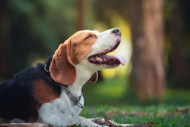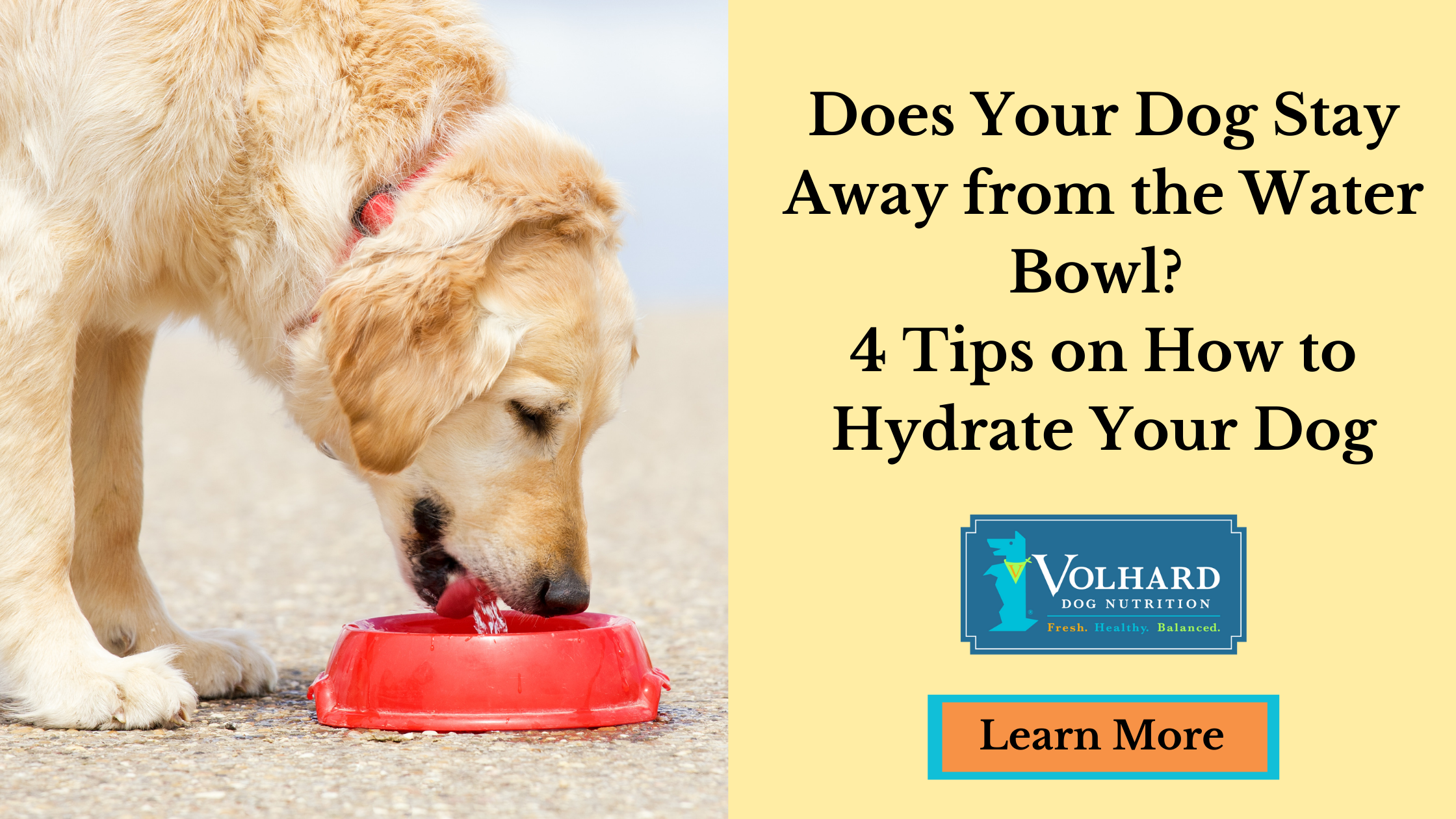Does Your Dog Stay Away From the Water Bowl? 4 Tips on How to Hydrate Your Dog
Posted by Volhard Dog Nutrition on Jun 16th 2021
The summer season we have all been anxiously waiting for is right at our doorstep. Thoughts of weekend road trips to the beach or peaceful afternoons spent by the comfort of a swimming pool are lurking in every corner of our minds, ready to remind us that the time has come for sunbathing and relaxation.
As the star Sirius is racing to bring the scorching dog days upon us, making sure that our water intake is sufficient becomes essential. This necessity applies not just to you but also your puppy, whose water intake habits require extra attention during the summer season. After all, it's more straightforward to observe dehydration signs in a human; dogs, on the other hand, will not cry out to you when they would fancy a water bowl refill.
Ensuring Proper Hydration for Your Dog
Here at Volhard, our firm belief is that you should feed a hydrated diet. If you feed a 100% dry dog food diet your dog will stay in a state of chronic dehydration putting strain on the dog’s organs. With the help of our team, you will learn more about dehydration in dogs, its causes and symptoms, and how to address it appropriately with a proper hydrated diet. Let's dive deeper into the subject and untangle everything there is to know about dehydration in dogs!
Observing Dehydration
It is normal for a dog’s body to gain and lose water throughout the day. Panting, breathing, urinating, defecating, and evaporation through the paws all contribute to normal water loss, which your dog compensates for by eating and drinking.
However, when your puppy's fluid intake doesn't supplement the amount it's losing, the body starts to suffer from dehydration. The first consequence of dehydration consists of a reduced blood flow, which, in turn, limits the amount of oxygen that reaches your dog's organs and tissues.
Lack of water intake can cause dehydration, which can occur if a dog doesn’t have proper access to water or won’t drink enough. Whether you’re at home or gone for part of the day, be sure to leave enough water so your dog will not run out.
Acute attacks of vomiting and diarrhea, heat stroke, or illnesses and a fever may also cause a dog to become dehydrated. Puppies, senior dogs, nursing mothers, and toy dog breeds may have an increased risk of dehydration. Sometimes dehydration in dogs is a symptom of an underlying cause, including these diseases or conditions: kidney disease, diabetes, or some types of cancer.
There are some dogs who just won’t drink much water unless they are encouraged to do so. Or they are exercising outside to the point where they are panting and therefore losing fluids.
How Do I Detect Dehydration in My Dog?
Dehydration signs in dogs might not be as apparent as one might think; the owner will have to keep a keen eye on the dog's water intake and corroborate that with other symptoms, which we'll discuss below.
So, how can you tell if your dog is dehydrated? Unfortunately, our dogs can’t tell us they’re thirsty, but knowing the signs of dehydration can help you respond quickly and also catch potential serious medical conditions before they become life-and-death emergencies. Some symptoms of canine dehydration include:
- Loss of skin elasticity
- Loss of appetite
- Vomiting with or without diarrhea
- Reduced energy levels and lethargy
- Panting
- Sunken, dry-looking eyes
- Dry nose
- Dry, sticky gums
- Thick saliva
Loss of skin elasticity is the easiest sign to test for dehydration. To test for it, we suggest that you gently hold some of the dog’s skin near his shoulder blades, raise it up, and then let it go. Watch carefully as it falls back into place. In well-hydrated dogs, the skin instantly will spring back to its original position. The skin of dehydrated dogs, on the other hand, will take longer to fall back into place. A second way to ascertain whether your puppy is dehydrated or not is a condition closely related to inadequate water intake: xerostomia. Commonly known as "dry mouth," this loss of moisture in the dog's gums causes its saliva to look thick and pasty. Noticing this clue will reveal your dog's dehydrated state.
Finally, you can do a capillary refill test to determine dehydration. Press your finger gently against your dog’s gums and then remove your finger. In a well-hydrated dog, the area where you pressed will appear white for a second, and then return to its normal pink color almost immediately. In dehydrated dogs, the capillary refill time takes much longer.
What About Electrolytes?
Many of us see dehydration as an easily fixable issue: stave off dehydration by more consistent water intake. However, water as a whole is not the only solution to this issue. Oftentimes, dehydration is merely a symptom of another problem, and in this case, your dog might be dealing with an electrolyte imbalance.
Electrolytes are ionized salts that circulate through the body and play a crucial role in nutrient absorption and cell osmosis. The most frequently observed electrolyte imbalances associated with dehydration concern sodium, potassium, and chloride, but other electrolytes that can become imbalanced include calcium, magnesium, and phosphate. These salts assist in the body's proper function through balancing the body's pH, facilitating muscle function, moving essential nutrients to cells, and, essential in this context, maintaining the proper amount of water in the body.
When the dog's body deals with an insufficient water intake, it automatically draws fluids out of cells for compensation, which, in turn, leads to electrolyte loss, affecting the body's proper function. Because water itself cannot provide all the necessary electrolytes, your responsibility as a dog owner is to make sure that your puppy receives proper electrolyte intake through other means, namely through adequate food intake. For dogs with more than three hours of activity a day, especially in hot/humid climates, giving an electrolyte boost is beneficial. In times of high activity, a dog’s water intake increases as well as their need for electrolytes. A solution based remedy would be to dilute coconut water and homemade bone broth to add into their drinking water; this helps to increase the mineral intake in addition to the increased fluids.
Now that we've seen how dehydration works, let's discuss how your dog can quickly achieve proper hydration and electrolyte intake with our four tips!
#1: Feeding Volhard Hydrated Food to Your Puppy!
The amount of water that your dog will drink daily mostly depends on the chosen diet. For example, if your dog's diet mainly consists of dry food with approx. 10% moisture, your dog will drink approx. a quart of water per every pound of dry food consumed. At least you hope so! At the opposite pole, a canned food diet rich in moisture (upward to 78%) will drink much less.
The Volhard Natural Diet contains an abundant source of moisture and electrolytes necessary for your dog's proper development and healthy life, which is why they will not ask for a water bowl refill too often. The Volhard Natural Diet Foundation contains numerous ingredients that will not only keep dehydration and electrolyte imbalance away but also check every single one of your dog's nutritional needs. Watch the following presentation and learn how easy it is to put together a nutritious food bowl for your dog!
#2: Switching to Natural Mineral Water
For those unending scorching days, your puppy will need extra help to retain water and electrolytes properly. That's when you should switch from plain water to natural mineral water, which is rich in the following minerals:
- Magnesium
- Calcium
- Potassium
- Iron
- Zinc
- Sodium
- Bicarbonate
With the help of natural mineral water, your puppy will receive the proper electrolyte intake and successfully retain the hydration from the water.
#3: Blue Electrolyte Bites Recipe!
Wait- I have heard of green spirulina, what is blue spirulina? Green Spirulina is a whole cell algae, so it tastes more than a smidge like… well… algae. Given that Blue Spirulina is an extract, the smell and flavour are much more neutral, making it easy to receive some of the benefits of spirulina without the fishy taste. Spirulina is a potent source of nutrients. It contains a powerful plant-based protein called phycocyanin. So what makes spirulina so great from a nutrition standpoint? Well, first of all, it contains high levels of many nutrients, including calcium, potassium, B vitamins, and iron. Here’s the nutritional breakdown for a single tablespoon of spirulina:
- 4 grams of protein
- 11% of the recommended dietary allowance (RDA) of vitamin B1 (thiamin)
- 15% of the RDA of vitamin B2 (riboflavin)
- 4% of the RDA of vitamin B3 (niacin)
- 21% of the RDA of copper
- 11% of the RDA of iron
In addition to all of that, spirulina also contains significant amounts of magnesium, potassium, and manganese. Magnesium plays a pivotal role in supporting muscle and nerve function, maintaining healthy blood sugar levels and blood pressure in the body, as well as making protein, bone, and DNA. Potassium, which is a type of electrolyte, aids in nerve function and muscle contraction, and it regulates your heartbeat. And finally, manganese helps your dog’s body develop and function properly throughout their life.
Research shows this may have antioxidant, pain-relief, anti-inflammatory, and brain-protective properties. Many antioxidants in spirulina have anti-inflammatory effects in the body.Need a quick and easy recipe to add electrolytes to your dogs diet? Thanks to Perfectly Rawsome - check out this Blue Electrolyte Bites Recipe!
Recipe Ingredients:
- Cottage Cheese: 10.7oz (302g)
- Coconut Water: 0.5 cup (120g)
- Blueberries: 3.5oz (100g)
- Presoaked Raw Sunflower Seeds: 1.6oz (45g)
- Coconut Oil: 2.25tbsp (30.6g)
- Honey: 1 tbsp (21g)
- Ground Chia Seeds: 0.2oz (5g)
- Wildly Blended Blue Spirulina: 0.5tbsp (3.5g)
- Egg Shell Powder: 1.25g
Recipe Instructions:
- Mix all the ingredients into a blender and blend on high until it is thoroughly mixed and has a creamy texture.
- Portion & freeze.
- Pour mixture into ice cube trays or into silicone molds for portion sizes, then freeze.
- Serve & watch your dog enjoy!
Conclusion
Feeding a hydrated diet like the Volhard Natural Diet and our tried-and-true tips, your puppy will be more than ready and happy to enjoy the warm summer days without fear of dehydration or an electrolyte imbalance. Would you like to learn more about proper hydration in dogs? Feel free to contact us or check out our blog!
Volhard Dog Nutrition and its expert nutritionists are now offering online consultations to help more dog parents discover why, what, and how to feed their dogs the healthiest of foods! Speaking to a Volhard nutritionist will help you understand the inseparable relationship between healthy food, a healthy body, and a healthy mind. If you're interested in contacting one of our Volhard nutritionists, don't hesitate to access our consultation page!


